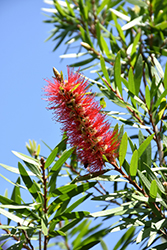It's all about ...
plants

Height: 15 feet
Spread: 8 feet
Sunlight:
![]()
![]()
Hardiness Zone: 10a
Description:
A bushy, evergreen, upright variety presenting slightly arching branches, clothed with narrow, pointed dark green leaves; intense scarlet red bottlebrush blooms appear in late spring to summer, possibly more; can be maintained as a small tree, or a hedge
Ornamental Features
Stiff Bottlebrush features showy spikes of scarlet catkins at the ends of the branches from late winter to late fall. Its fragrant narrow leaves remain green in colour throughout the year.
Landscape Attributes
Stiff Bottlebrush is an open multi-stemmed evergreen perennial with an upright spreading habit of growth. It brings an extremely fine and delicate texture to the garden composition and should be used to full effect.
This is a relatively low maintenance plant, and is best cut back to the ground in late winter before active growth resumes. It is a good choice for attracting bees and hummingbirds to your yard. It has no significant negative characteristics.
Stiff Bottlebrush is recommended for the following landscape applications;
- Mass Planting
- General Garden Use
- Container Planting
Planting & Growing
Stiff Bottlebrush will grow to be about 15 feet tall at maturity, with a spread of 8 feet. It has a low canopy with a typical clearance of 1 foot from the ground. Although it is technically a woody plant, this plant can be expected to behave as a perennial in our climate if planted outdoors over the winter, usually regrowing from its base (crown) the following year. As such, gardeners should take into consideration that it will perform differently than it would in its native habitat.
This plant does best in full sun to partial shade. It prefers to grow in average to moist conditions, and shouldn't be allowed to dry out. It is not particular as to soil type or pH. It is somewhat tolerant of urban pollution. This species is not originally from North America.
Stiff Bottlebrush is a fine choice for the garden, but it is also a good selection for planting in outdoor pots and containers. Its large size and upright habit of growth lend it for use as a solitary accent, or in a composition surrounded by smaller plants around the base and those that spill over the edges. It is even sizeable enough that it can be grown alone in a suitable container. Note that when growing plants in outdoor containers and baskets, they may require more frequent waterings than they would in the yard or garden. Be aware that in our climate, most plants cannot be expected to survive the winter if left in containers outdoors, and this plant is no exception. Contact our experts for more information on how to protect it over the winter months.
This plant is not reliably hardy in our region, and certain restrictions may apply; contact the store for more information.

